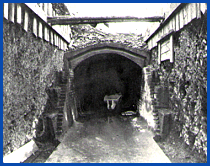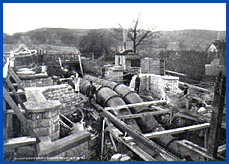
The Elan Valley aqueduct 2
Cross-country waterways
The Elan Valley aqueduct used a combination of three types of construction, depending on the nature of the terrain it had to cross.
"Cut and cover" was essentially a brick lined channel which was manually dug as a trench, then roofed over and concealed underground. A photograph of this technique in use in 1898 to build a section of the 73 mile long aqueduct is shown below. The water travels along these sections like an underground stream, and about 25 miles of the total is of this type.
An example of
'cut and cover'
on the route
of the aqueduct,
February 1898
 Where the route of the
aqueduct encountered high ground above the gradient needed to
maintain the downward slope, a certain amount of tunneling was
required using the same type of channel as above. This totalled
around 12 miles, with the longest single length being just over
4 miles.
Where the route of the
aqueduct encountered high ground above the gradient needed to
maintain the downward slope, a certain amount of tunneling was
required using the same type of channel as above. This totalled
around 12 miles, with the longest single length being just over
4 miles.crossing the
Caethon stream,
February 1897
(far right)
 opped too
steeply for the required hydraulic gradient. The pipeline was
continued at the other side of the valley at the same height
as the delivery pipe, as the water naturally fills the pipe due
to the head of water travelling along behind. The route of the
aqueduct had to cross eleven major valleys.
opped too
steeply for the required hydraulic gradient. The pipeline was
continued at the other side of the valley at the same height
as the delivery pipe, as the water naturally fills the pipe due
to the head of water travelling along behind. The route of the
aqueduct had to cross eleven major valleys.Most of the pipes were made of cast iron, with some sections, such as the syphon which crosses the River Severn, made of welded steel to cope with very high pressures. The syphon which crosses the Rivers Severn and Stour is over 17 miles long.